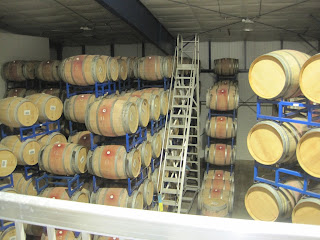Chapter IV Lewis and Clark and the Upper Columbia River
We visit to the Whitman Mission, Three Rivers Winery, and Sacajawea State Park
On our long overnight cruise back from Clarkston/Lewiston on the night of Oct. 7 we passed back through several locks on the Snake and back onto the Columbia River. I'm not completely sure where we docked, but it was either Burbank or Wallula, Washington. All I know is I woke up to some loud crashes outside. I got dressed and walked down the hall to the stern, As soon as I opened the door, I could see that a pile of crushed automobiles were being loaded onto a barge. We were moored right alongside a junkyard. I made a note in my journal that reality can always sneak in and take a swipe at the river's natural beauty. It was a dissonance that only evaporated by participating in the more pleasant experience of a breakfast of fresh baked sweet rolls, a cheesy egg casserole, and some of the most delicious thick cut bacon I have ever tasted.
Shortly after that breakfast we boarded a coach that took us through the fertile countryside to the grounds of what is now known as the Whitman Mission. It was founded in 1836 as the Mission at Waiilatpu and was a major way station on the historic route of the Oregon Trail. Missionaries Marcus and Narcissa Whitman were among the first inhabitants and also the last as they were both killed in an Indian uprising in 1847.
The Mission is now a National Historic Site and there are nicely paved walks that take you to the locations of the old buildings.
We were most intrigued by the still visible old wagon wheel tracks from the Oregon Trail.
A wagon replica helped to imagine what that great journey must have been like.
High on a hill overlooking the mission site is the Whitman Memorial placed there in 1897 to commemorate the fiftieth anniversary of the Whitman's deaths.
Their sad end gave us another reminder of the strange unintended consequences of history. The missionaries came with a fervent desire to save the people they thought to be savages, but brought with them the white man's diseases as well as their own civilization. To those of us--which means most of us--who are now celebrating Thanksgiving on land that used to belong to the indigenous peoples of the continent, perhaps we ought to pause a bit to think of those who came before and did prepare the way.
Unfortunately the visitor center at the Whitman Mission had just closed for the season when we arrived and after the ranger took us on a walk around the grounds, we re-boarded our buses to head for the Three Rivers Winery. There we were treated to information about viticulture followed by a nourishing lunch and the best part of visiting wineries--the samples.

After lunch we toured the inside of the winery and saw the fermentation process in action.

Two huge vats of crushed grapes drew a lot of attention. And of course one of our group had to ask the old question, "Do you still stomp on the grapes?" Our guide was practiced and used the query to help him launch an explanation of the hygiene required in today's facilities.

The oak barrels in the aging area were stacked high.

With that we returned to the sales room where bottles of the available brews could be ordered to take back to the ship or be shipped to your home or to friends and relatives.


Luckily, the visitor center was still open here. First let's deal with the particular issue of how to pronounce Sacagawea. For most of my life I have heard the name as Sack-a-jah-we-a. Our guides and most modern sources now say the truer pronunciation is Sa-cog-a-we-a I won't go heavy on the history of this heroic woman here as it can be found in many places. All I will say is that while wintering with the Mandan Indians in North Dakota on their first westward journey Lewis and Clark met a French-Canadian trapper named Toussaint Charbonneau and hired him as an interpreter. Charbonneau's young wife was a Shoshone Indian who had been kidnapped at the age of 12 and then sold to the trapper. She was allowed to accompany her husband and gave birth to a son named Jean Baptiste in February of 1805 while traveling with the party. Her contributions along the way were many, varied, and historic.

The interior of the museum has some nice diorama paintings including an illustration of how the pioneer wagons were adapted to river raft travel by removing their wheels.
Another one showed what the keel boat used on the Missouri River might have looked like.
The natives apparently didn't think the Lewis and Clark were much good at making or handling them. I certainly don't think I would have made it as a member of the crew.
https://www.confluenceproject.org/river-site/sacajawea-state-park/
Thanks for reading and I hope to see you in the next chapter when we will go through the famous Wallaua Gap and into the Columbia Gorge.

















No comments:
Post a Comment